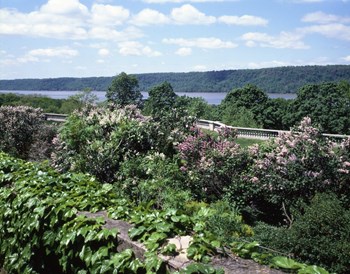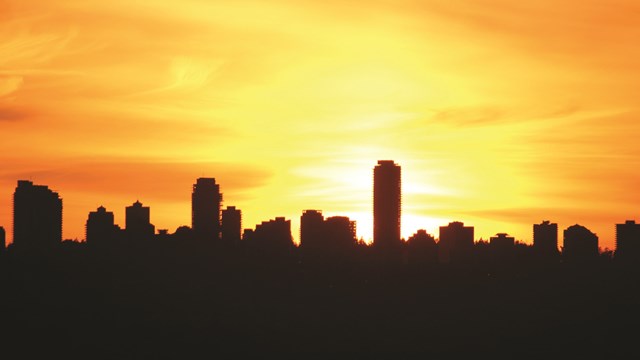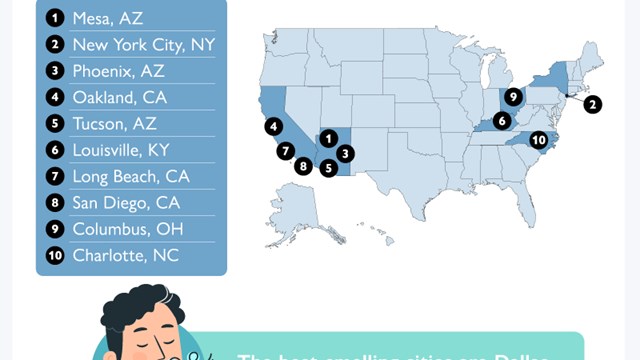
When people think of the Bronx, most probably picture an urban landscape of tenements and commercial buildings surrounded by acres of concrete and asphalt—the image of a leafy suburban enclave is perhaps not the first thing that comes to mind. That's one of the things that makes the neighborhood known as Riverdale so special.
Bounded on the west by the Hudson River and on the north by the Westchester County line, with borders extending south to 224th Street and east to Van Cortlandt Park and the Henry Hudson Parkway, Riverdale's landscape is characterized by winding streets, hilly terrain, and dramatic rocky outcroppings along the river. A large portion of the neighborhood has been designated a greenbelt, with open spaces, public facilities and outdoor recreational opportunities, and the views of the high, rocky cliffs of the Palisades and the Hudson River are magnificent.
Indeed, not much has changed in the landscape since The WPA Guide to New York City, published in 1939, described Riverdale this way: "The homes are set along rambling lanes; on the crests of hills overlooking the Hudson; atop ravines that lead to the river; amid flower gardens and picturesque rock formations."
Thanks to strict zoning regulations, the neighborhood has more or less maintained its look and character since the WPA Guide was published—but that's not to say the area hasn't borne witness to some interesting changes over the years.
Meadows and Mansions
In 1786, farmer William Hadley bought the wooded hilly tract that is now Riverdale as a homestead on which he intended to cultivate and raise livestock. His near neighbor, Frederick Van Cortlandt, was successfully farming wheat. The Van Cortlandt House, which was built in 1748, claims the title of the oldest surviving residence in the Bronx, and is now a museum. George Washington made it his headquarters several times during the Revolutionary War.
Though they struggled on their new land, the Hadley family did not succeed as farmers, and eventually sold the land to Major Joseph Delafield in 1829. Delafield had discovered the area as a member of the Army Corps of Engineers. He was supervising the building of forts on Staten Island and Brooklyn, and he needed a source of limestone. He found the source along what is now Palisades Avenue in Riverdale.
Delafield built his own vacation place on the tract he purchased from the Hadley family. Before the Civil War, Delafield started selling off portions of land to well-heeled New Yorkers for summer homes away from the oppressive heat and cholera epidemics of the crowded city, or as weekend retreats during the winter months. Many of the homes—many of them mansions—remain, and some are open to the public as museums and historic properties. The families who built in Riverdale during the Civil War era included the Colgates of soap and toothpaste fame, the Dodges of the copper mining dynasty, and famous actor Edwin Forrest, whose Fonthill Castle is now the administration building for the College of Mount Saint Vincent. Some famous Bronxites are actors Danny Aiello, Tony Curtis, and Hal Linden, actresses Anne Bancroft and June Allyson, singers Jennifer Lopez and Billy Joel, designers Calvin Klein and Ralph Lauren, and former New York City Mayor Fiorello LaGuardia.
At the turn of the 20th century, Riverdale was still primarily a bucolic summer retreat with several dozen families living on large private properties overlooking the Hudson River, but as rail commuting to Manhattan became easier, Riverdale became ripe for the next wave of development. Charming, eclectic single-family homes were built by the score in the 1920s. The influential domestic architect of the time, Dwight James Baum (brother of Wizard of Oz creator Frank) left his legacy with homes of Tudor, Cotswold Cottage, Georgian, and Spanish Colonial design. When the Henry Hudson Bridge and Parkway were built in 1936, more people sought the small town ambience just across the Harlem River.
The post World War II building boom hit Riverdale with multi-family dwellings and large apartment buildings, many of which eventually became co-ops. Most Riverdalians then were young growing families whose breadwinners could easily commute down into Manhattan to work, and after work retreat to one of the most beautiful sections of New York City.
It's still a quick trip today. Transportation via the MTA's 1 and 9 subway lines, express buses, and the Metro North Railroad can take a Riverdale resident to the heart of Manhattan in about 20 to 40 minutes. By car, at the right time of the day, the trip can be even less than that. It's also an easy commute to northern New Jersey or Westchester as well.
The Housing Market
While new residential construction is largely comprised of condos, co-ops tend to predominate in Riverdale. On average, according to Barbara Jurist, an associate broker with Sotheby's Real Estate in Riverdale and a resident of the neighborhood for four decades, prices for one- and two-bedroom co-ops typically linger in the mid six figures—quite a bit less than comparable Manhattan properties.
According to Kristen M. Hackett, vice president of Robert E. Hill, Inc., a Riverdale-based realty firm, "There are fewer condos in Riverdale than co-ops. Prices for condos are generally about 15 percent higher than co-ops. You will see a wide range of prices in co-ops here depending on what part of the neighborhood [they're in] and whether it is a prewar of post-war building. For instance, a two-bedroom in a very nice Central Riverdale co-op with an elevator but no doorman might run in the low $300,000s, but a two-bedroom in a higher-end doorman building with a river view could be in the $500,000 range and higher."
Linda Solomon, a broker with Halstead Property Riverdale LLC, adds that: "It really does vary. Condos are kind of a new entity to Riverdale, and the new developments are at much higher price points. I have a two-bedroom, two-bath co-op with an open kitchen and dining area in a prewar building east of the highway that's fully renovated, but not a doorman building. And we have it listed for $389,000 with common charges of $477 per month. That's versus a small three-bedroom condo in a brand new development where they have lowered the [asking prices] to about $699,000 and up."
Desirable as Riverdale homes may be to many people, the recession did not spare the area entirely. "Overall, we saw prices drop as much as 20 to 25 percent last year for houses and co-ops," says Hackett. "We're seeing about a 10 percent recovery now from that low point, and we're seeing quite a bit of new development here as well. The sales in these buildings have been slow, but they are beginning to pick up in several of the buildings such as the Latitude and Riverstone, just to name a couple. Some of the developers have decided to rent as an alternative at this time."
Solomon agrees. "We made a lot of corrections," she says, "but things seem to have settled. We're really trying to stay with the market. When you price it right, it sells."
Why Riverdale?
According to Hackett, "What attracts buyers to Riverdale for the most part is the proximity to Manhattan but with an attractive price differential. [You get] so much more apartment for your money here. Riverdale is also interesting. The best way to describe it is urban-suburban. It has bucolic neighborhoods with gorgeous trees—like the Fieldston Estate area west of the Parkway, North Riverdale, Spuyten Duyvil and Central Riverdale—but it's only 15 or 20 minutes to midtown.
According to Solomon, a longtime Riverdalian herself, buyers are drawn to Riverdale for a host of other reasons as well. "There are lots and lots of parks. And safety. Easy access to Manhattan. It's 22 minutes from the Spuyten Duyvil station to Grand Central on Metro North and a five-minute bus ride to the #1 express buses. People want to get away from the noise, and they get it here. It's quiet. I raised both my children here, so I'm living here 40 years. My husband has a business down the street, so we're pretty ensconced in the neighborhood. There's Wave Hill, which is fabulous—it has great programs for children and for adults—for anyone that wants nature and be close to the beautiful river views."
Robert Wachsman, a real estate broker with Riverdale Homes, LLC, says his family moved to Riverdale in the 1960s from another part of the Bronx, and remembers his mother telling of taking delightful family outings to the countryside of Riverdale to picnic when she was a child. Riverdalians tend to stay in the neighborhood—even staying within buildings for generations. The population—about 25,000—has been stable for the last few decades, with people who moved into a one-bedroom 35 years ago moving to larger places with more bedrooms as their families grew and then downsizing back to smaller spaces as the children grow and leave.
In recent years, there has been an increase in singles moving into Riverdale and many retirees as well are opting to stay rather than move to warmer climates. The retirees that are exiting Manhattan and taking advantage of equity from their homes, discover they can get more space for less money in Riverdale. Even a number of out-of-staters are choosing to retire there. According to Jurist, Riverdale almost has the feel of a quiet, friendly village, "but the entertainment and excitement of Manhattan is just 20 easy minutes away."
Green Jewels in the Crown
Among Riverdale's most outstanding features are the area's parks and museums. Wave Hill is a 28-acre park devoted to the connection between humans and nature. Providing the neighborhood with an oasis of natural beauty and serenity, it has internationally-acclaimed gardens, horticultural collections, and two historical house museums. Wave Hill House, built in 1834 in the Greek Revival style by noted lawyer William Lewis Morris, was enlarged in 1866 and 1890 by succeeding owners. Wave Hill House was host to many famous guests, including Charles Darwin, Mark Twain, and Theodore Roosevelt. Also on the property is Glyndor, built in the 1860s and a fine example of the Georgian Revival style. Wave Hill is open year round and offers many different programs about horticulture, as well as concerts in the summer.
The Judaica Museum of the Hebrew Home for the Aged features an extraordinary collection of Jewish and Hebrew textiles, art objects, and paintings. The museum is an educational resource with changing exhibits, and - like almost every place in Riverdale—the grounds command impressive views of the Hudson River and the Palisades.
Outdoor activities abound as hiking trails and paths are numerous. The Riverdale Ramble is an annual 10K race sponsored by the Van Cortlandt Track Club. The race has been run for nearly 30 years, and is advertised as "running through one of the most unique neighborhoods in the whole metropolitan area. You might find it hard to believe that you're still in New York City as you weave through lush parklands, fabulous estates, magnificent mansions and high rise co-ops."
Riverdalians agree their "village-like neighborhood" is unique to New York City. Area residents have painstakingly preserved and maintained their neighborhood's personality, charm, green spaces, and historical and cultural attractions. "There's something for everyone," says Solomon. "It's a great alternative."
Annette Hall is a freelance writer living in Framingham, Massachusetts. Additional research and writing by David Chiu and Hannah Fons.






Leave a Comment